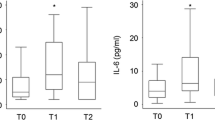Abstract
Summary
We found an association between the presence of Chlamydia pneumoniae DNA both in osteoporotic bone tissue and peripheral blood mononuclear cells (PBMCs) and the increase in circulating resorptive cytokines.
Introduction
Our study was designed to determine whether C. pneumoniae infection may be involved in osteoporosis-associated bone loss.
Methods
The study included 59 women undergoing hip joint replacement surgery for femoral neck fracture: 32 with osteoporosis and 27 with osteoarthritis. A total of 118 tissue specimens (59 bone tissues, 59 PBMCs) were examined for C. pneumoniae DNA by real-time polymerase chain reaction (PCR). Serum levels of soluble receptor activator of nuclear factor kappa B ligand (sRANKL), osteoprotegerin (OPG), interleukin (IL)-1β, tumor necrosis factor-α, and IL-6 were also measured.
Results
C. pneumoniae DNA was detected in osteoporotic bone tissue whereas it was not found in non-osteoporotic bone tissue (p < 0.05). A significantly higher rate of C. pneumoniae DNA (p < 0.05) was found in PBMCs of osteoporotic patients than in those of osteoarthritis patients. Among osteoporotic patients, serum sRANKL, IL-1, and IL-6 concentrations as well as sRANKL/OPG ratio significantly differ between patients with bone tissue and PBMCs positive to C. pneumoniae and C. pneumoniae-negative patients.
Conclusion
The association between the presence of C. pneumoniae DNA, both in bone tissue and PBMCs, and the increase in sRANKL/OPG ratio as well as in IL-1β and IL-6 levels observed in osteoporotic patients suggests C. pneumoniae infection as a new risk factor for osteoporosis.
Similar content being viewed by others
References
Rachner TD, Khosla S, Hofbauer LC (2011) Osteoporosis: now and the future. Lancet 377:1276–1287
Brewer L, Williams D, Moore A (2011) Current and future treatment options in osteoporosis. Eur J Clin Pharmacol 67:321–331
Claro T, Widaa A, O’Seaghdha M, Miajlovic H, Foster TJ, O’Brien FJ, Kerrigan SW (2011) Staphylococcus aureus protein A binds to osteoblasts and triggers signals that weaken bone in osteomyelitis. PLoS One 6:e18748
Schreiner H, Markowitz K, Miryalkar M, Moore D, Diehl S, Fine DH (2011) Aggregatibacter actinomycetemcomitans-induced bone loss and antibody response in three rat strains. J Periodontol 82:142–150
Delpino MV, Fossati CA, Baldi PC (2009) Proinflammatory response of human osteoblastic cell lines and osteoblast-monocyte interaction upon infection with Brucella spp. Infect Immun 77:984–995
Graves D (2008) Cytokines that promote periodontal tissue destruction. J Periodontol 79:1585–1591
Marriott I (2004) Osteoblast responses to bacterial pathogens: a previously unappreciated role for bone-forming cells in host defense and disease progression. Immunol Res 30:291–308
Bailey L, Engström P, Nordström A, Bergström S, Waldenström A, Nordström P (2008) Chlamydia pneumoniae infection results in generalized bone loss in mice. Microbes Infect 10:1175–1181
Rizzo A, Di Domenico M, Carratelli CR, Mazzola N, Paolillo R (2011) Induction of proinflammatory cytokines in human osteoblastic cells by Chlamydia pneumoniae. Cytokine 56:450–457
Di Pietro M, Tramonti A, De Santis F, De Biase D, Schiavoni G, Sessa R (2012) Analysis of gene expression in penicillin G induced persistence of Chlamydia pneumoniae. J Biological Regulators & Homeostatic Agents 26:277–284
Bellmann-Weiler R, Martinz V, Kurz K, Engl S, Feistritzer C, Fuchs D, Rupp J, Paldanius M, Weiss G (2010) Divergent modulation of Chlamydia pneumoniae infection cycle in human monocytic and endothelial cells by iron, tryptophan availability and interferon gamma. Immunobiology 215:842–848
Rosenfeld ME, Campbell LA (2011) Pathogens and atherosclerosis: update on the potential contribution of multiple infectious organisms to the pathogenesis of atherosclerosis. Thromb Haemost 106:858–867
Sessa R, Nicoletti M, Di Pietro M, Schiavoni G, Santino I, Zagaglia C, Del Piano M, Cipriani P (2009) Chlamydia pneumoniae and atherosclerosis: current state and future prospectives. Int J Immunopathol Pharmacol 22:9–14
Gracey E, Inman RD (2011) Chlamydia-induced ReA: immune imbalances and persistent pathogens. Nat Rev Rheumatol 8:55–59
Villareal C, Whittum-Hudson JA, Hudson AP (2002) Persistent Chlamydiae and chronic arthritis. Arthritis Res 4:5–9
Netea MG, Selzmann CH, Kullberg BJ (2000) Acellular components of Chlamydia pneumoniae stimulate cytokine production in human blood mononuclear cells. Eur J Immunol 30:541–549
Takano R, Yamaguchi H, Sugimoto S, Nakamura S, Friedman H, Yamamoto Y (2005) Cytokine response of lymphocytes persistently infected with Chlamydia pneumoniae. Curr Microbiol 50:160–166
Merkel KD, Erdmann JM, McHugh KP, Abu-Amer Y, Ross FP, Teitelbaum SL (1999) Tumor necrosis factor-α mediates orthopedic implant osteolysis. Am J Pathol 154:203–210
WHO Study Group (1994) Assessment of fracture risk and its application to screening for postmenopausal osteoporosis. Report of a WHO Study Group World Health Organ Tech Rep Ser 843:1–129
Sessa R, Di Pietro M, Schiavoni G, Petrucca A, Cipriani P, Zagaglia C, Nicoletti M, Santino I, del Piano M (2007) Measurement of Chlamydia pneumoniae bacterial load in peripheral blood mononuclear cells may be helpful to assess the state of chlamydial infection in patients with carotid atherosclerotic disease. Atherosclerosis 195:e224–e230
Gieffers J, van Zandbergen G, Rupp J, Sayk F, Krüger S, Ehlers S, Solbach W, Maass M (2004) Phagocytes transmit Chlamydia pneumoniae from the lungs to the vasculature. Eur Respir J 23:506–510
Gérard HC, Schumacher HR, El-Gabalawy H, Goldbach-Mansky R, Hudson AP (2000) Chlamydia pneumoniae present in the human synovium are viable and metabolically active. Microb Pathog 29:17–24
Carter JD, Gérard HC, Espinoza LR, Ricca LR, Valeriano J, Snelgrove J, Oszust C, Vasey FB, Hudson AP (2009) Chlamydiae as etiologic agents in chronic undifferentiated spondylarthritis. Arthritis Rheum 60:1311–1316
Teti A (2011) Bone development: overview of bone cells and signaling. Curr Osteoporos Rep 9:264–273
Acknowledgments
Funding for this study was provided by the Center for Social Disease Research, “Sapienza” University, Rome to R. Sessa.
Conflicts of interest
None.
Author information
Authors and Affiliations
Corresponding author
Rights and permissions
About this article
Cite this article
Di Pietro, M., Schiavoni, G., Sessa, V. et al. Chlamydia pneumoniae and osteoporosis-associated bone loss: a new risk factor?. Osteoporos Int 24, 1677–1682 (2013). https://doi.org/10.1007/s00198-012-2217-1
Received:
Accepted:
Published:
Issue Date:
DOI: https://doi.org/10.1007/s00198-012-2217-1




